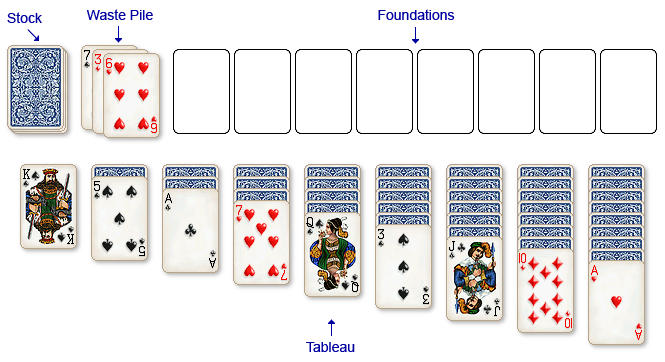You probably have this game on your computer. It's an all time classic to play when bored and it can be a really addicting pastime. The colors of the cards is the most important lesson!
Klondike is a form of solitaire which means single player card games. I think most people would recognize this game through their computer since it's one of windows most classic "games which comes with the machine". I also think almost everyone has played it at least once, and the design of this game makes it easy to pick up at all times. Here is a link to the rules, let's begin cutting it open!
Core Loop
The core loop of Klondike consists of
Move card(s) --> Reveal card
Mechanics
Moving a card is clicking a card which lies on top of either the tableau, waste pile or foundation and then dragging that card to another card on the tableau which is one number higher and in a different color.
You can move to another card on the foundation with a number which is one lower and in the same suit. Aces can be moved to empty spaces in the foundation.
Revealing a card is done when there is only face down cards in one column on the tableau in which case you flip the topmost card face-up.
The players action is moving of the cards. The reward for moving cards correctly is the revealing of the card beneath. Some cards are allowed to be collected based on previous cards collected. This is the core loop of the game which repeats itself.
The first thing of interest is the how the colors of the cards interact with each other. Since the player always needs to look at what cards they need to move right now, the color of the cards not only makes them easier to search for, but it also shapes an appealing pattern when laying them on top of other cards. Humans love seeing patterns everywhere, and this core loops abuses it.
The revealing of the cards is also interesting. It comes as a reward which feels nice for the player, but it also creates a sense of suspense to find out what new possibilities comes for future needs. Maybe you've been waiting for an 8 to come along for some time now. You will wish for that 8 for every card you reveal, hoping it will give you the miracle you need.
Aesthetics
Challenge: Logic puzzle(Brain teaser?)
Submission: Rules indulgence
As a single player card games with non-narrative cards, submission and challenge is what Klondike is achieving. There are rules which you follow strictly(Submission) and the game is really challenging to complete(Challenge). It's the type of game where the rules are simple while figuring out how to use them well is a bit complex which creates the challenge of wanting to understand the system. Since the game isn't hard to play and can be fun to sit through even without thinking too hard about it I would say challenge is a minor Aesthetic. The rules are everything in this game, and the player only moves according to the rules. Which means we can turn our brains off the let ourselves indulge in the game world.
Takeaways
I'll be doing this also. Because if you are just analyzing, then you're missing the point of analyzing. We're doing this to improve, so what can we learn from Klondike?
The game's Aesthetic wants us to relax and sit back and it does it through it's really good set of rules and especially in the number/color matching which creates patterns every human loves. The takeaway here is that pattern matching makes really good submission games(Oh right candy crush saga makes so much sense now...).

No comments:
Post a Comment